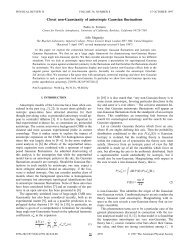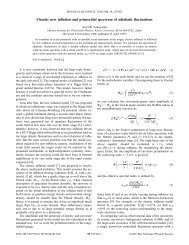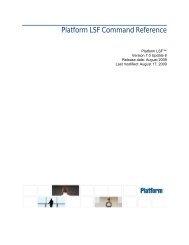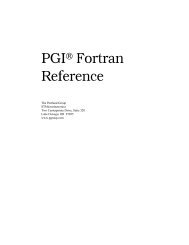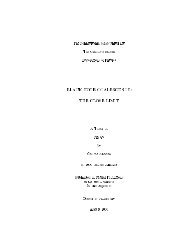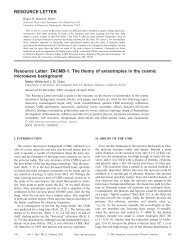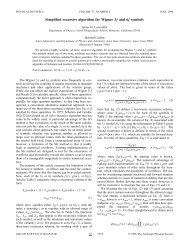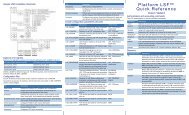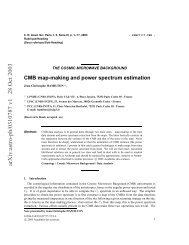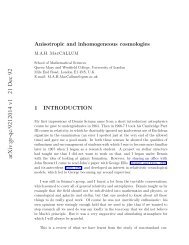Exact computation of the 3-f and 6-f symbols - iucaa
Exact computation of the 3-f and 6-f symbols - iucaa
Exact computation of the 3-f and 6-f symbols - iucaa
Create successful ePaper yourself
Turn your PDF publications into a flip-book with our unique Google optimized e-Paper software.
S. -T. La,, Y -N. Chiu / <strong>Exact</strong> <strong>computation</strong> <strong>of</strong> <strong>the</strong> 3-f <strong>and</strong> 6-f <strong>symbols</strong> 351<br />
<strong>and</strong> for <strong>the</strong> 6-f symbol as<br />
{ } Ji J2 ~ = (_1)h+J2~4±J5([(f, —12 +f 3)!( f4 +J~ J3)!(J4 —15 +f3)!(—f4 ~f2 +j3)!<br />
14 15 16<br />
x (f ~f2 —f6)!(14 ~12 +16+ 1)!( —14 ~J2 +f6)!(jl +f~—j6)!(j1 —15 +16)!<br />
x (—f’ ~15 +f~)!J/ [(f1+f~—f~)!(f1~f2 +13 + 1)!(_f~+12+13)!<br />
x (14 ~15~J6 + 1)!(f4 12 +f6)!(fl +15+16 + 1)!] }1/2<br />
L f~+12 —13 14 12 +16 —11 +J~+13 [ L + 1<br />
x~(—1) L—f4—f5—f3 L—f1—f2—f3 L—f1—f5—f6 ~L—f4—j2—f6<br />
where (~)‘s are <strong>the</strong> binomial coefficients. In eqs. (1) <strong>and</strong> (2), <strong>the</strong> summation is over all positive integral<br />
values <strong>of</strong> L such that none <strong>of</strong> <strong>the</strong> factorials is negative. The main point is, how can we conveniently deal<br />
with <strong>the</strong> large factorials exactly. We designed subroutines DECOM(L1,QK,R9) <strong>and</strong> PRIME(DIA,QK,R9)<br />
which decompose each integer into a product <strong>of</strong> prime numbers with certain powers. In eqs. (1) <strong>and</strong> (2),<br />
<strong>the</strong> value inside <strong>the</strong> square root is easy to compute, even if <strong>the</strong> jr’s (x = 1, 2, 3,.. . ,6) inside <strong>the</strong> square root<br />
are very large. But <strong>the</strong>re is a limitation on <strong>the</strong> f values that can be manipulated in <strong>the</strong> summation part.<br />
Since each binomial coefficient is always an integer, <strong>the</strong> limitation <strong>of</strong> our computer requires that <strong>the</strong><br />
product <strong>of</strong> <strong>the</strong> three or four binomial coefficients cannot be beyond iO~~when we use Real * 1 6(H — floating)<br />
on <strong>the</strong> Digital VAX computer. The value <strong>of</strong> H~floatingdata is in <strong>the</strong> approximate range 0.84 x 10 4932<br />
to 0.59 x 104932. The precision <strong>of</strong> H_floating data is approximately one part in 2112, i.e. typically 33<br />
decimal digits. According to our <strong>computation</strong> <strong>the</strong> 3-f <strong>symbols</strong> up to ~ ~ m3) <strong>and</strong> 6-f <strong>symbols</strong> up to<br />
~ } can be h<strong>and</strong>led on <strong>the</strong> VAX/VMS computer. 3g ~ That ~), ( means ~ _ ~) <strong>the</strong><strong>and</strong> values ( ~ <strong>of</strong>~ 3-f }, <strong>and</strong> ( ~ 6-f ~} <strong>symbols</strong> <strong>and</strong> some are<br />
exact approximate for <strong>the</strong>values abovefor values. larger We f’sgive in appendices examples <strong>of</strong> A ( <strong>and</strong> B.<br />
(2)<br />
3. Description <strong>of</strong> <strong>the</strong> program<br />
The program contains five subroutines <strong>and</strong> one function which are named A3JSY (for <strong>computation</strong> <strong>of</strong><br />
3-f symbol), A6JSY (for <strong>computation</strong> <strong>of</strong> 6-f symbol), PRIM1(Q1) (for <strong>computation</strong> <strong>of</strong> selected prime<br />
numbers below 602), DECOM(L1,QK,R9), PRIME(DIA,QK,R9) <strong>and</strong> FUNCTION DIFAC(N) (for<br />
<strong>computation</strong> <strong>of</strong> factorials). For 3-f symbol calculation with integer f, we input angular momentum<br />
numbers f~12’ 13’ <strong>and</strong> magnetic quantum numbers m<br />
1, m2, m3. We give examples that are available in<br />
Rotenberg’s book <strong>and</strong> can be checked against <strong>the</strong> latter. For example, for (1~1~~ we input 16.0, 16.0, 6.0,<br />
0.0, 0.0, 0.0 from <strong>the</strong> WIG.DAT file, for half-integer 3-f symbol, for example, (~—9/2 —1/2)’ we input 8.0,<br />
7.5, 6.5, 5.0, —4.5, —0.5. The procedures for <strong>computation</strong>s <strong>of</strong> 6-f <strong>symbols</strong> are parallel to that for 3-f<br />
<strong>symbols</strong>. The input WIG.DAT file format can be found in appendix C.<br />
4. Output<br />
The output shows <strong>the</strong> 3N-f <strong>symbols</strong> (N = 1, THRJ; N = 2, SIXJ) equal to a sign (+ 1.0 <strong>and</strong> —1.0)<br />
multiplied by <strong>the</strong> prime numbers <strong>of</strong> given powers. The program output is as follows:



